 W
WThe Bocchoris vase is a ceramic container dating from ancient Egypt. It was found in 1895 in a tomb at Tarquinia, and is now in the National Museum at Tarquinia. The vessel, often also labelled as situla and made of Egyptian faience, bears an inscription with the names of the 24th Dynasty pharaoh Wahkare Bakenrenef who ruled about 720 to 715 BC. It shows the king between the Egyptian goddess Neith and the god Horus in the middle register, on one side and on the other between Horus and Thoth. In the lower register are shown Kushite prisoners between monkeys eating dates from palm trees, a depiction which was considered by Egyptologist Toby Wilkinson as racial propaganda. The vessel is an important evidence for long distance trade in the 9th and 8th century BC. It is furthermore of some importance for dating earlier phases of Etruscan culture in Italy. Because of the good preservation of the vessel, it has been argued that it came very shortly after it was made into the Etruscan tomb.
 W
WThe Bryant Vase is a late 19th-century vase currently in the collection of the Metropolitan Museum of Art.
 W
WThe Caylus vase is a jar in alabaster dedicated in the name of the Achaemenid king Xerxes I in Egyptian hieroglyph and Old Persian cuneiform. It was the key element in confirming the decipherment of Old Persian cuneiform by Grotefend, through the reading of the hieroglyphic part by Champollion in 1823. It also confirmed the antiquity of phonetical hieroglyphs before the time of Alexander the Great, thus corroborating the phonetical decipherment of the names of ancient Egyptian pharaohs. The vase was named after Anne Claude de Tubières, count of Caylus, an early French collector, who had acquired the vase in the 18th century, between 1752 and 1765. It is now located in the Cabinet des Médailles, Paris.
 W
WThe Chatham Vase is a stone sculpture by John Bacon commissioned as a memorial to William Pitt the Elder by his wife, Hester, Countess of Chatham. It was originally erected at their house in Burton Pynsent in 1781. It was subsequently moved to Stowe House but sold in 1848, then purchased in 1857 by a member of the family and installed at Revesby Abbey. It was moved to the grounds of Chevening House in 1934, where it currently resides. It is currently grade II listed.
 W
WThe Derveni Krater is a volute krater, the most elaborate of its type, discovered in 1962 in a tomb at Derveni, not far from Thessaloniki, and displayed at the Archaeological Museum of Thessaloniki. Weighing 40 kg, it is made of a bronze with a high tin content of about 15%, which endows it with a superb golden sheen without use of any gold at all. It is dated to the 4th century BC, and was probably made in Athens. Large metalwork vessels are extremely rare survivals in Ancient Greek art, and the Derveni Krater is the outstanding survival from Hellenistic art, as the Vix Krater is from the Archaic period.
 W
WThe Fonthill Vase, also called the Gaignières-Fonthill Vase after François Roger de Gaignières and William Beckford's Fonthill Abbey, is a bluish-white Qingbai Chinese porcelain vase dated to 1300-1340 AD. It is the earliest documented Chinese porcelain object to have reached Europe. The vase was made in Jingdezhen, China, and comes from the final years of Qingbai ware in Jingdezhen before it was replaced by the new blue and white porcelain, which started in earnest after 1320. It is an unusual "experimental" vase with applied relief decoration in the medallions, in the usual monochrome blueish-white Qingbai glaze.
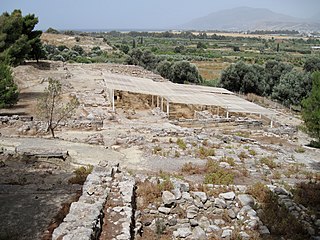 W
WHagia Triada is the archaeological site of an ancient Minoan settlement. Hagia Triada is situated on the western end of a prominent coastal ridge, with Phaistos at the eastern end and the Mesara Plain below. Hagia Triada has yielded more Linear A tablets than any other Minoan site. Important finds include the Hagia Triada sarcophagus, and three carved stone vessels, known as the "Chieftain's Cup", the "Boxer Vase", and the Harvester Vase.
 W
WThe Hüseyindede vases are Early Hittite vases decorated with reliefs, which were found in excavations at Hüseyindede Tepe near Yörüklü in the Turkish province of Çorum. There are fragments of four vases in total. Two of them were nearly complete and were able to be restored. The vases, dated to approximately 1650 BCE, are on display in the Çorum Archaeological Museum.
 W
WAmes Van Wart. Indian Vase, 1876. Marble, 46 1/2 x 24 x 16 in.. The Metropolitan Museum of Art, New York, Gift of Estate of Marshall O. Roberts, 1897 (97.10). On view in gallery 760. From the Met’s website: “Its motifs explicitly acknowledge the displacement of Indigenous Americans by Euro-American settlement in the West”.
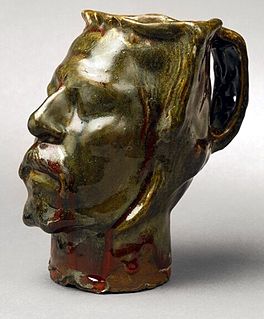 W
WJug in the form of a Head, Self-portrait was produced in glazed stoneware early in 1889 by the French Post-Impressionist artist Paul Gauguin. This self-portrayal is especially stark and brutal, and was created in the aftermath of two traumatic events in the artist's life. In December 1888 Gauguin was visiting Vincent van Gogh in Arles when Van Gogh hacked off his left ear before leaving it at a brothel frequented by them both. A few days later in Paris, Gauguin witnessed the beheading of the notorious murderer Prado. Gauguin shows his severed head, dripping with rivulets of blood, his ear cut off, his eyes closed as if in denial.
 W
WThe Londonderry Vase is a hard-paste porcelain vase, standing at 54 inches tall. It is decorated with polychrome enamels, gilding and gilt bronze mounts. It bears the Sèvres mark, two intersecting Ls with a letter in the center denoting its creation year (1813-1815) and a crown over the L's to mark it as hard-paste. The vase was commissioned by Napoleon around 1805 to be created by the Sèvres Manufactory. The vase is currently on display at the Art Institute of Chicago.
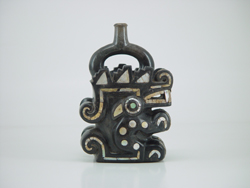 W
WThe Moche Crawling Feline is a specific stirrup spout vessel dating from 100—800 CE. This Moche ceramic effigy is currently in the collection of Larco Museum, in Lima, Peru. It comes from the North Coast of Peru. It represents a zoomorphic character: a lunar dog, or a crawling feline.
 W
WThe Panagyurishte Treasure is a Thracian treasure.
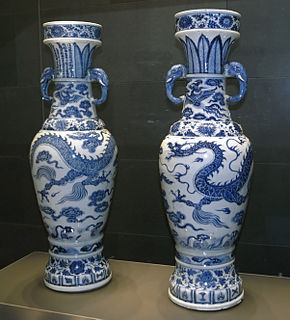 W
WThe Percival David Foundation of Chinese Art holds a collection of Chinese ceramics and related items assembled by Percival David that are on permanent display in a dedicated gallery in Room 95 at the British Museum. The Foundation's main purpose is to promote the study and teaching of Chinese art and culture. The collection consists of some 1,700 pieces, mostly of Song, Yuan, Ming and Qing dynasty porcelain from the 10th century to the 18th. It includes a painting, Scroll of Antiquities.
 W
WThe Portland Vase is a Roman cameo glass vase, which is dated to between AD 1 and AD 25, though low BC dates have some scholarly support. It is the best known piece of Roman cameo glass and has served as an inspiration to many glass and porcelain makers from about the beginning of the 18th century onwards. It is first recorded in Rome in 1600–1601, and since 1810 has been in the British Museum in London. It was bought by the museum in 1945 and is normally on display in Room 70.
 W
WThe Rubens vase is a Late Antique or early Byzantine hardstone carving of a single piece of agate in the form of a vase, named after a later owner, Peter Paul Rubens,, who in Flanders made a pen drawing of it, which is now held in the Hermitage Museum. It is believed to have been commissioned by a Byzantine emperor, perhaps around 400 AD, and made in Constantinople. That it appeared in Europe after the Sack of Constantinople by the Fourth Crusade, may indicate that it was the result of plunder. After passing through the collections of the Dukes of Anjou, Charles V, Peter Paul Rubens, and the Mughal Emperor Jahangir, it was eventually purchased by Henry Walters.
 W
WPot pourri à vaisseau or pot pourri en navire is the shape used for a number of pot-pourri vases in the form of masted ships, first produced between the late 1750s to the early 1760s by the Sèvres manufactory near Paris. The colours and details of the painted decoration vary between examples, as is typical of Sèvres porcelain, and one example is on a later gilt wood stand. The openwork lid lifts off to allow refilling of the pot-pourri. The shape was eventually produced in two or three versions, at slightly different sizes. It was first designed in 1757, probably by Jean-Claude Duplessis, the artistic director of the factory. The first surviving finished example dates to 1759. Another name for them is vaisseau à mat.
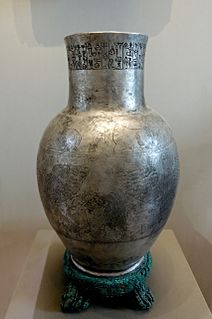 W
WThe Vase of Entemena is a tripod type silver vase and was named after Entemena, the ruler of Lagash.
 W
WVase with carved peony scrolls is a Cizhou-type stoneware vase of the Northern Song dynasty, made about 1100 and now in the Asian collection of the Indianapolis Museum of Art, where it is currently on display in the Richard M. Fairbanks Gallery.
 W
WVase with lid is a 1926 vase by René Crevel. It is in the collection of the Metropolitan Museum of Art.
 W
WThis vase with a nine peach design is part of the Chinese collection of the Indianapolis Museum of Art, which is in Indianapolis, Indiana, United States. It is a fine piece of Jingdezhen porcelain with overglaze decoration dating from the Qianlong period of the Qing dynasty, so it was made between 1736 and 1795.
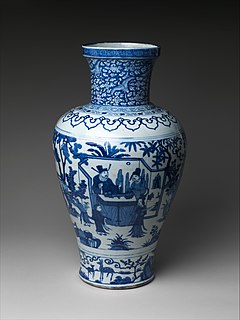 W
WThe Vase with the Poet Zhou Dunyi is a traditional Chinese porcelain vase produced in 1587, during the Ming Dynasty. The Vase can be identified by its Wanli Mark and period qualities, constituting its cobalt blue paintings decorating the transparent glazed porcelain. The Vase is now in the Metropolitan Museum of Art in New York City, purchased via the credit line of the Rogers Fund within the Museum. The structure and shape of the vase in accompaniment to the complex iconography is notable as it is meant to encouraging the viewer to read and understanding the image presented and their value in Chinese literati culture.
 W
WThe Vix Grave is a burial mound near the village of Vix in northern Burgundy. The broader site is a prehistoric Celtic complex from the Late Hallstatt and Early La Tène periods, consisting of a fortified settlement and several burial mounds.
 W
WThe Wardak Vase is the name of an ancient globular-shaped buddhist copper vase that was found as part of a stupa relic deposit in the early nineteenth century near Chaki Wardak in Wardak Province, Afghanistan. The importance of the vase lies in the long Kharoshthi inscription, which claims that the stupa contained the relics of the Buddha. Since 1880, the vase has been part of the British Museum's Asian collection.
 W
WThe Warka Vase or Uruk vase is a slim carved alabaster vessel found in the temple complex of the Sumerian goddess Inanna in the ruins of the ancient city of Uruk, located in the modern Al Muthanna Governorate, in southern Iraq. Like the Uruk Trough and the Narmer Palette from Egypt, it is one of the earliest surviving works of narrative relief sculpture, dated to c. 3200–3000 BC. Simple relief sculpture is also known from much earlier periods, from the site of Göbekli Tepe, dating to circa 9000 BC.